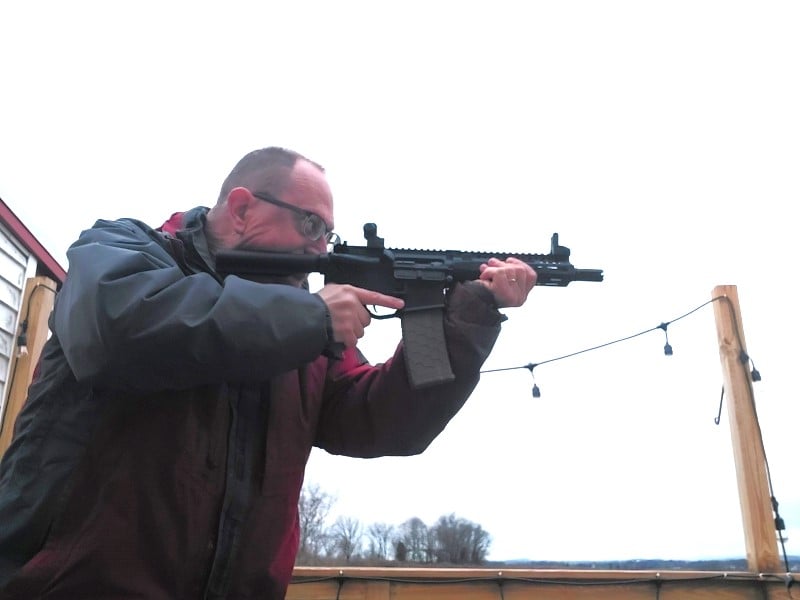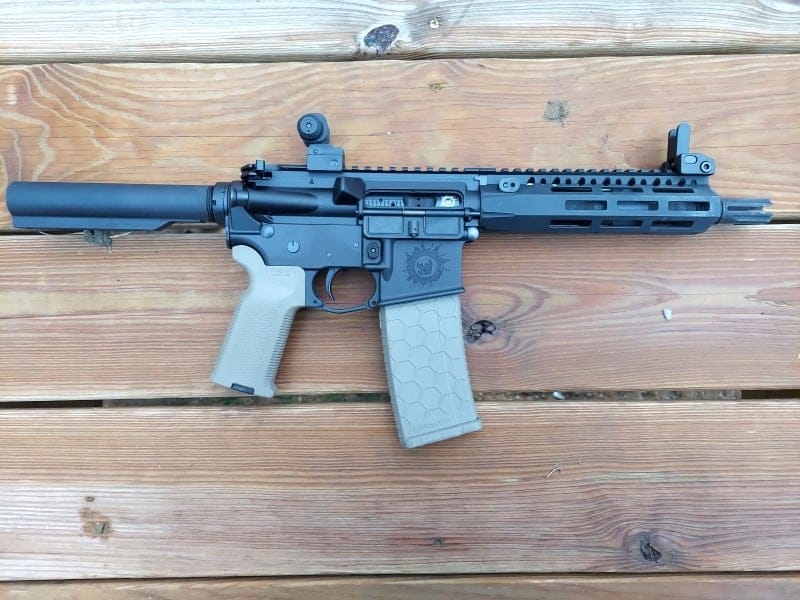Most of us have heard about the ATF’s reversal/flip-flop on their pistol brace decision. A number of years ago (in 2017, as a matter of fact), they declared pistol braces to be legal and even went so far as to issue a letter stating the same, to the relief of many AR pistol owners.
However, most of us missed one tiny detail when they did this—no one ever declared “No backsies!”
So here we are, five years later, and the ATF flip-flopped, now declaring the vast majority of pistol braces have turned those pistols into “short-barreled rifles.” This ex-post-facto ruling is unquestionably unconstitutional. And it is being challenged by lawsuits even as I type this.
All of that leads me to my point: If we have to make do with our AR pistols without a brace, can we effectively still fire them with any semblance of accuracy?
The answer is yes. Follow along and I’ll show you.
A Long Time Ago
…in a galaxy far, far away. I was beginning my career in law enforcement and we were being formally schooled in the art of firing a rifle. My agency issued the Winchester Model 70 (Pre-’64) in 7mm Mauser. Those old rifles were a marvelous thing of beauty—micrometer sights, heavy steel, and wood. Just beautiful.
Our NRA-certified instructors taught us how to form a pocket in our shoulder by lifting our arm horizontally and placing the bottom of the stock into that pocket.
Well, we certainly won’t be doing that with our AR pistols if the US Government has anything to say about it. Apparently doing so makes those short-barreled firearms more deadly than long-barreled firearms.
Points of Contact
Shouldering a long gun gives us several points of contact.
- Two with our hands.
- One against our cheek/jaw.
- One against our shoulder.
I’m not skilled at mathematics, but I come up with four points of contact. Double-check me, if you would, and let me know in the comments section if I messed that up.
The more points of contact that the weapon has with our body, the better. These points tend to steady the weapon as we aim. And the more points of contact that our body has with Mother Earth, the better for accuracy (but that’s for another article).
Let’s examine these points of contact.
One hand is typically out on the forearm, holding the end of the weapon up. That happens whether or not the weapon has a stock or not.
The other hand is rearward, either on the weapon’s stock near the receiver or on the pistol grip, assuming said weapon is so equipped. So far, so good.
With only those two points of contact, our accuracy is not going to be as good as it could be, and it will take a lot of work to try to line up the sights. The weapon will feel like a seesaw, of sorts, tipping to and fro. Add a little physical exertion in there and it all goes topsy-turvy.
Since we’re missing that point of contact with the shoulder, things get a little dicey. However, we’re in for a slight bit of luck here. The AR-15 in its pure form, by design, has what is referred to as a buffer tube.
The buffer tube is integral to the function of the AR-15. It’s where the buffer spring is housed, which the bolt slams into when the weapon is fired. It then sends the bolt flying back home into the chamber, which chambers the next round.
This buffer tube extends back several inches. Actually, it’s a bit over six inches. Not really long enough for most of us to rest it against our shoulder, unless we have extremely short arms.
Alternatives
This brings me to my next point. That buffer tube can still serve us as far as a point of contact is concerned.
Remember the cheek weld that we’d get when you shouldered the weapon and on the rare occasions when we’d use the brace to place against our shoulder? Well, I never used the brace as a shoulder stock, but maybe some of you out there did.

At any rate, that buffer tube can still give us a decent cheek weld. Just like it does when we shoulder an AR-15 carbine that has a stock. It’s that third point of contact that we can get, in addition to our two hands.
Personally, I pull the buffer tube in pretty tight to my cheek and jaw area. Fortunately, the recoil of the AR in 5.56mm is not bad, so we don’t have to worry much about our jaw being slammed by recoil. If we’re firing a .308, that might be a different story.
No, it is not as good, as comfortable, or as stable as when we use a shoulder stock. The pistol will move around a little more than if we had a real stock against our shoulder because we can’t pull the weapon in tight to our shoulder. Especially when things are dynamic and we are moving.
However, it’s a hell of a lot steadier than if we just grasped said pistol in our two paws and performed a “Spray and Pray” exercise at the range.
And, because our face and eyes are in the same place as if we were using a shoulder stock, we can still see the sights exactly the same as if we would be using a stock. Just plant your cheek against the same spot on the buffer tube as you always have.
The bottom line with it is that we’ll have to exercise some effort and practice with technique. I’m not aware of anyone else talking about this technique, but I’m sure there are others out there who also realize that it’s a thing. I seriously doubt that I’m the first person to come up with this technique.
Shouldering?
Is it possible at all to shoulder that buffer tube on the AR pistol? Well…maybe sometimes. No, I haven’t lost my mind. But there are times when we might be wearing a heavy winter coat, which adds some thickness up around the shoulder/chest area for us. There are also occasions when we are wearing load-bearing gear such as a chest rig. Those things also add thickness to our shoulder area. It’s just possible that the extra thickness added might allow us to jam that buffer tube base into our shoulder.

Is it practical or realistic? It all depends on your body makeup and the gear used. It’s worth a try to experiment with the gear you’re using and see what happens.
Reloading
Another challenge with a stockless AR pistol will be reloading.

Typically, when inserting a fresh magazine into an AR-15, the stock/brace and buffer tube are either kept on the shoulder or pinched between the inside of the arm and the shooter’s ribcage. With less surface area (no brace/stock) and less length, that can’t really happen.

The best technique I’ve come up with thus far is to raise the muzzle of the pistol, plant the base of the buffer tube into my armpit, and then insert the magazine.
Again, it’s not optimal, but we’re at the “Improvise, Adapt, Overcome” stage here.
Advantages?
Are there still any advantages to owning an AR pistol now that we can’t have a brace?
For certain, the short length is still an advantage. An AR pistol can still stow into small spaces in vehicles and backpacks. As for moving around inside structures or vehicles, we still have that very compact nature retained.

To Sum It Up
Only time and the courts will tell us how this thing is going to play out. The government’s move is a very troubling overreach of power that should make us all wary, whether or we own a pistol or not. It begs the question, if they’re confident enough to try this, what’s next?
The bottom line? All is not lost if we can’t use a pistol brace. We can still obtain some accuracy and enjoy a compact weapon.


